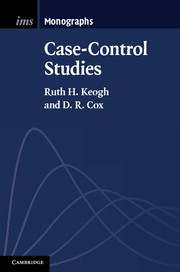Book contents
- Frontmatter
- Contents
- Preface
- Preamble
- Notes
- 1 Introduction to case-control studies
- 2 The simplest situation
- 3 Matched case-control studies
- 4 A general formulation
- 5 Case-control studies with more than two outcomes
- 6 Special sampling designs
- 7 Nested case-control studies
- 8 Case-subcohort studies
- 9 Misclassification and measurement error
- 10 Synthesis of studies
- Appendix: A theoretical diversion
- References
- Index
7 - Nested case-control studies
Published online by Cambridge University Press: 05 April 2014
- Frontmatter
- Contents
- Preface
- Preamble
- Notes
- 1 Introduction to case-control studies
- 2 The simplest situation
- 3 Matched case-control studies
- 4 A general formulation
- 5 Case-control studies with more than two outcomes
- 6 Special sampling designs
- 7 Nested case-control studies
- 8 Case-subcohort studies
- 9 Misclassification and measurement error
- 10 Synthesis of studies
- Appendix: A theoretical diversion
- References
- Index
Summary
The nested case-control design accommodates case event times into the sampling of controls.
In this design one or more controls is or are selected for each case from the risk set at the time at which the case event occurs. Controls may also be matched to cases on selected variables.
Nested case-control studies are particularly suited for use within large prospective cohorts, when it is desirable to process exposure information only for cases and a subset of non-cases.
The analysis of nested case-control studies uses a proportional hazards model and a modification to the partial likelihood used in full-cohort studies, giving estimates of hazard ratios. Extensions to other survival models are possible.
In the standard design, controls are selected randomly from the risk set for each case; however, more elaborate sampling procedures for controls, such as counter-matching, may gain efficiency. A weighted partial-likelihood analysis is needed to accommodate non-random sampling.
Preliminaries
We have focused primarily so far on case-control studies in which the cases and controls are sampled from groups of individuals who respectively do and do not have the outcome of interest occurring within a relevant time window. This time window is typically relatively short. If cases are to be defined as those experiencing an event or outcome of interest occurring over a longer time period, or if the rate of occurrence of the event is high, then the choice of a suitable control group requires special care.
Information
- Type
- Chapter
- Information
- Case-Control Studies , pp. 160 - 190Publisher: Cambridge University PressPrint publication year: 2014
Accessibility standard: Unknown
Why this information is here
This section outlines the accessibility features of this content - including support for screen readers, full keyboard navigation and high-contrast display options. This may not be relevant for you.Accessibility Information
- 3
- Cited by
